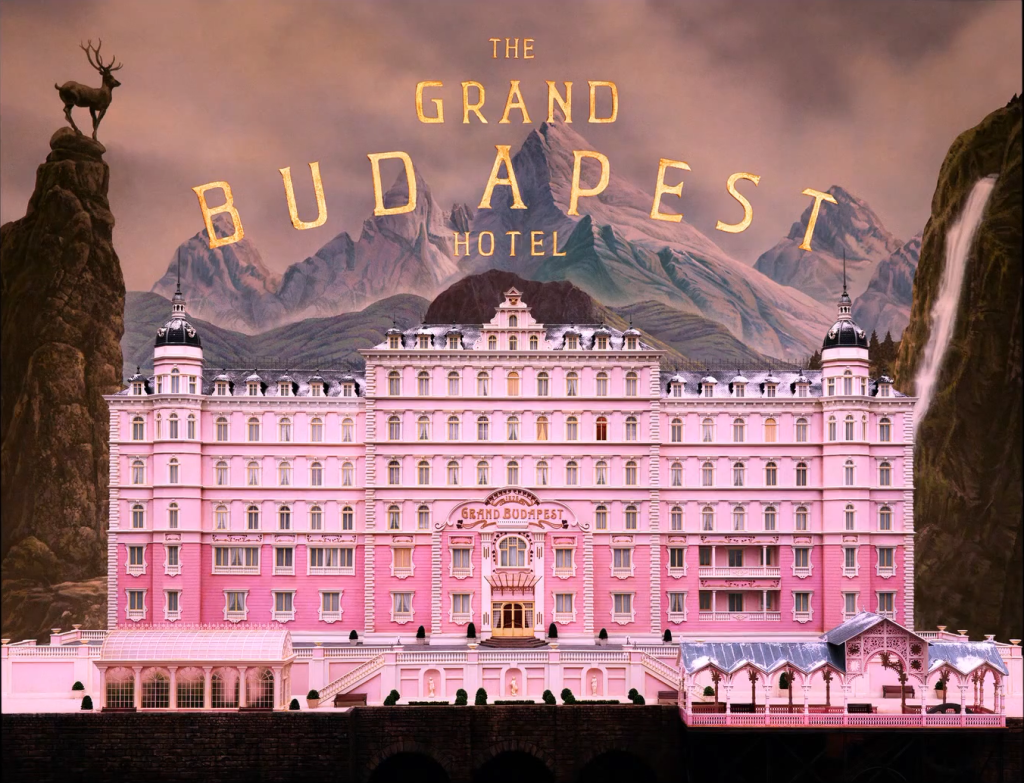 Go ahead and take a look at this particular IMDB page here, especially the “Director” section, and take a moment to assess those titles. Are they familiar, and if so, did you enjoy them? Because that’s Wes Anderson, and this is a Wes Anderson movie, which is to say, if you enjoyed any of those movies, there is a good chance you will enjoy “The Grand Budapest Hotel.”
Go ahead and take a look at this particular IMDB page here, especially the “Director” section, and take a moment to assess those titles. Are they familiar, and if so, did you enjoy them? Because that’s Wes Anderson, and this is a Wes Anderson movie, which is to say, if you enjoyed any of those movies, there is a good chance you will enjoy “The Grand Budapest Hotel.”
Not to say that this is just “more of the same.” On the contrary, though utilizing many of the same aesthetic and visual elements as he has throughout his career (to the point where he has Alexandre Desplat doing his best Mark Mothersbaugh impersonation for the last couple of soundtracks), “The Grand Budapest Hotel” is still rather unique and different from his other movies. This is his first movie to use flashback as the main narrative device (actually it’s a flashback within a book written by one of the movie’s character), and by telling this story in two different time periods, Anderson felt the urge to play around with the movie’s aspect ratios as well, presenting all of the 1930’s portion of this movie in something closer to 4:3, like a big old square, which is how movies were shot during those days, and which is something that Anderson has never really messed around with before. His first five movies were all shot in 2.35:1, which is your traditional widescreen, and his last two were shot in 1.85:1, which is the slightly stubbier, shorter cousin of 2.35:1.
Okay, this technical tangent (which I know so many of you are just LOVING) got me to doing a little research on this thing called the interwebs and here is a little history lesson for your film history lovers (the rest of youse can go straight to the next paragraph): so 4:3 (also known as 1.33) was actually the aspect ratio used most in the silent film era. But the introduction of sound in the late 1920’s apparently threw everyone for a bit of a loop, resulting in some monkeying around with aspect ratios. And basically, long story short, this lead to 1.375:1, which quickly became adopted as the go-to ratio for the talking movies, and every single Hollywood studio production from 1932 through the early 50s was shot in 1.375:1, which became known as the “Academy Ratio,” as the AMPAS peeps were the ones behind this ratio anyway. So the Academy Ratio came into being in 1932 and guess what? “The Grand Budapest Hotel?” Set in 1932. So there you go. “You just got learned!” (trademark pending)
So “The Grand Budapest Hotel” starts with a girl reading a book called The Grand Budapest Hotel, and she starts reading the book while visiting the memorial of the book’s deceased author. We then see the author as an old man (Tom Wilkinson) reciting the opening of the book. We then cut to the opening of the book, in which the author is a young man (Jude Law) and he meets the owner of this grand but broken down hotel, a man named Zero (F. Murrary Abraham). The two sit down to dinner and the hotelier tells his story about how he started as the hotel Lobby Boy (Tony Revolori) and assistant to M. Gustave (Ralph Fiennes), whom this whole movie is really about.
The story is pretty much told from Zero’s perspective, and he was always tagging around with M. Gustave, so it’s Gustave’s story about how he got some inheritance from one of the old hotel patrons he was shnogging (which he apparently did for all of his older lady guests) and how the rest of that old lady’s family most certainly did NOT appreciate that. There is also a bit about the apparent love of Zero’s life, as well as allusions to “the war” and whatnot, but really this whole movie is about M. Gustave’s insistence on clinging to the more proper ways of life, even when confronted with things like prison sentences and roaming death squads and a murderous and vengeful family with increasingly bad manners. So even when M. Gustave must and absolutely MUST let out a string of expletives, there is just proper about the way he deals out these curses that just makes it THAT much more delightful.
This movie doesn’t really have the same emotional punch that makes Anderson’s strongest movies like “The Royal Tenanbaums” and “Moonrise Kingdom” really resonate, but it’s still a very good movie with a few surprises, more than a couple of tender moments, and much more dark and violent humor than I would ever expect from a Wes Anderson movie, which is a good thing because it adds to the surprise of the film, as there was something that I honestly never really thought I’d see in a Wes Anderson movie in this picture (something that seems at home in a Tarantino or Scorsese movie, and maybe that’s part of the point of its inclusion? Because it is a first?). The story gets more plot-twisty and hinges more on intrigue and mystery than Anderson’s other movies, which usualyl center on something as easily identifiable as young love, or first love, or children wanting their parents’ love, stuff like that. The love in this movie? Besides from Zero’s new girlfriend Agatha, it is M. Gustave’s love of the hotel and of the older, more refined ways of doing things and living life.
Maybe if the story focused solely on M. Gustave, or conversely focused solely on Zero, then maybe there would have been more character development allowing for more emotional resonance, but really a large part of the fun of this movie is M. Gustave’s relationship with Zero and how they work together and become friends and whatnot. So would we really want to cut that down? I don’t think so.
So this is still a lovely movie anyway, because even though it didn’t make me want to cry or anything, it is still immensely enjoyable and a pleasure to watch, and makes for yet another fine entry into the filmography of Wes Anderson.

 Review: ‘Everest’
Review: ‘Everest’ Spillover Bonus Episode – The Hollyweird Reporter
Spillover Bonus Episode – The Hollyweird Reporter #479 – I Am Legends
#479 – I Am Legends Netflix pick for 4/30/13 – ‘Safety Not Guaranteed’
Netflix pick for 4/30/13 – ‘Safety Not Guaranteed’
Leave a Reply
You must be logged in to post a comment.